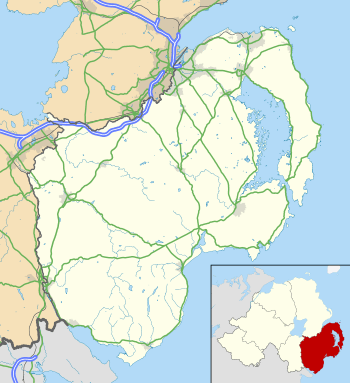Dromara
Dromara (from Irish: Droim mBearach, meaning "ridge of heifers")[1] is a small village, townland (of 242 acres) and civil parish in County Down, Northern Ireland. It lies 10 kilometres (6.2 mi) to the southwest of Ballynahinch on the northern slopes of Slieve Croob, with the River Lagan flowing through it. It is situated in Dromara (civil parish) and the historic barony of Iveagh Lower, Lower Half.[2] In the 2001 Census it had a population of 597 people.
Dromara
| |
|---|---|
 St John's Church, Dromara | |
 Location within County Down | |
| Population | 597 (2001 Census) |
| Irish grid reference | J287497 |
| • Belfast | 20 mi (32 km) |
| District | |
| County | |
| Country | Northern Ireland |
| Sovereign state | United Kingdom |
| Post town | DROMORE |
| Postcode district | BT25 |
| Dialling code | 028, +44 28 |
| UK Parliament | |
| NI Assembly | |
History
There have been references to a church at Dromara since about 1306. Earlier anglicised names for the church and townland include Drummeragh, Drumaragh and Drumara—these are likely derived from Druim mBearach (modern Irish Droim mBearach) meaning "ridge of heifers".[1] Saint John’s Church now occupies the site of the original church. Dromara eventually became a small mill village and although many of its buildings date from the early 19th century, the street pattern suggests that the settlement has a much earlier history. It used to have its own court and market house and a market place at the road junction in the middle of the village.
Facilities
Facilities in the village include Dromara Primary School, two churches (St John’s Church of Ireland and Dromara Second Presbyterian Church). Each summer the Dromara Vintage Club hold a vintage rally in the village.
Places of interest
- Legannany Dolmen, a prehistoric three legged 'giants grave' is just outside the village.
- Binder's Cove - a rediscovered souterrain near Finnis, Dromara. Finnis Souterrain (a scheduled ancient monument) is known locally as 'Binders Cove'. Although the first recorded discovery of Binder's Cove was in the 18th Century, it actually dates back to the 9th century. Souterrains were "underground stone lined tunnels". Because there was much clann feuding and raiding from foreign invaders such as the Vikings in the Early Christian period, souterrains are thought to have been places of refuge for the occupants of the monastery or its attached enclosure. They may also have been 'safes' where valuable gold and silver religious artefacts were kept. As they were dark, cold and dry, food might also have been stored in them.
Sport
Dromara Village F.C. play association football in the Northern Amateur Football League.
People
- Harry Ferguson, world-famous inventor of the modern gearbox and the 'Ferguson' Tractor, was born near Dromara.
- William Smith, born in Saintfield on 3 January 1801, military (Crimean War, 1853-1856), then travelling merchant, finally dean of humanity, died in Dromara on 4 November 1926.[3]
- Zak Hanna-International mountain runner for Ireland and Northern Ireland. Winner of the 2017 Slieve Donard mountain race and Irish Novice Cross Country Champion 2018/2019, also ranked 12th in the World Mountain Running rankings for 2018.
Demography
Dromara is classified as a Small Village by the NI Statistics and Research Agency (NISRA) (i.e. with population between 500 and 1,000 people). On Census day (29 April 2001) there were 597 people living in Dromara. Of these:
- 26.8% were aged under 16 years and 17.4% were aged 60 and over
- 49.6% of the population were male and 50.4% were female
- 21.9% were from a Catholic background and 76.3% were from a Protestant background
- 1.7% of people aged 16–74 were unemployed
For more details see: NI Neighbourhood Information Service
See also
- Dromara (civil parish)
- Market Houses in Northern Ireland
- List of civil parishes of County Down
References
- Placenames NI Archived March 31, 2012, at the Wayback Machine
- "Dromara". IreAtlas Townlands Database. Retrieved 19 May 2015.
- Le Matin (Paris), 18 février 1926, p. 1.
